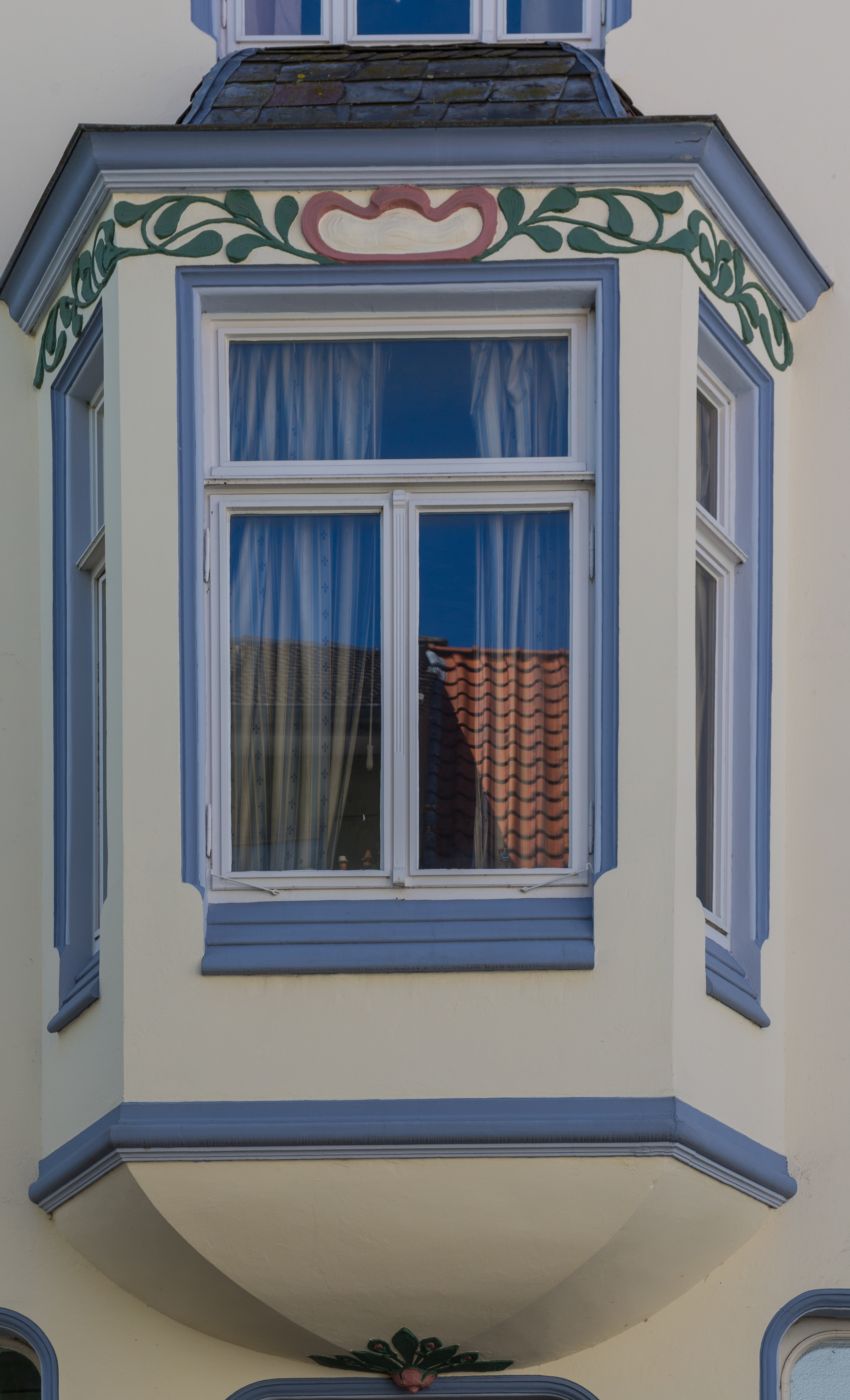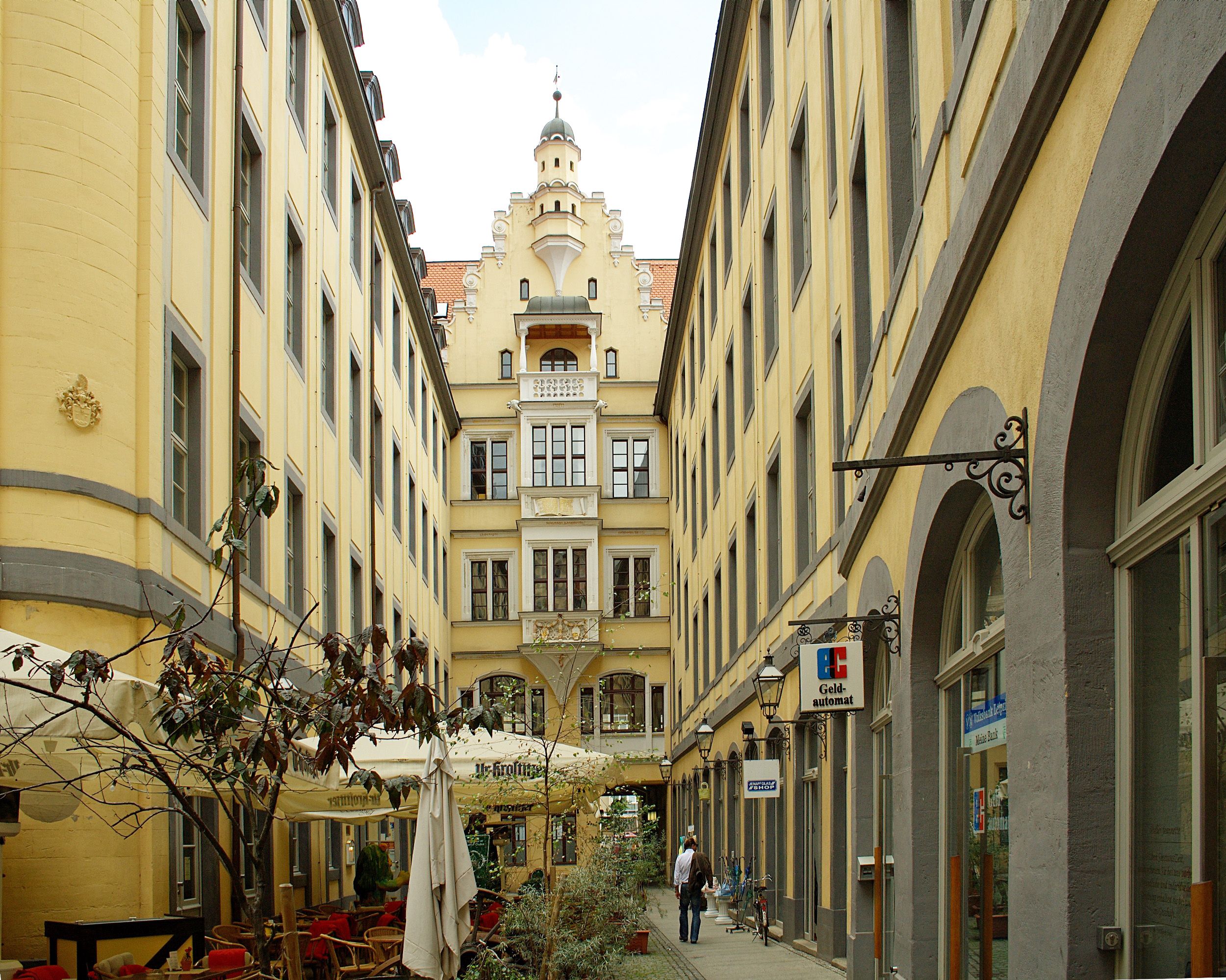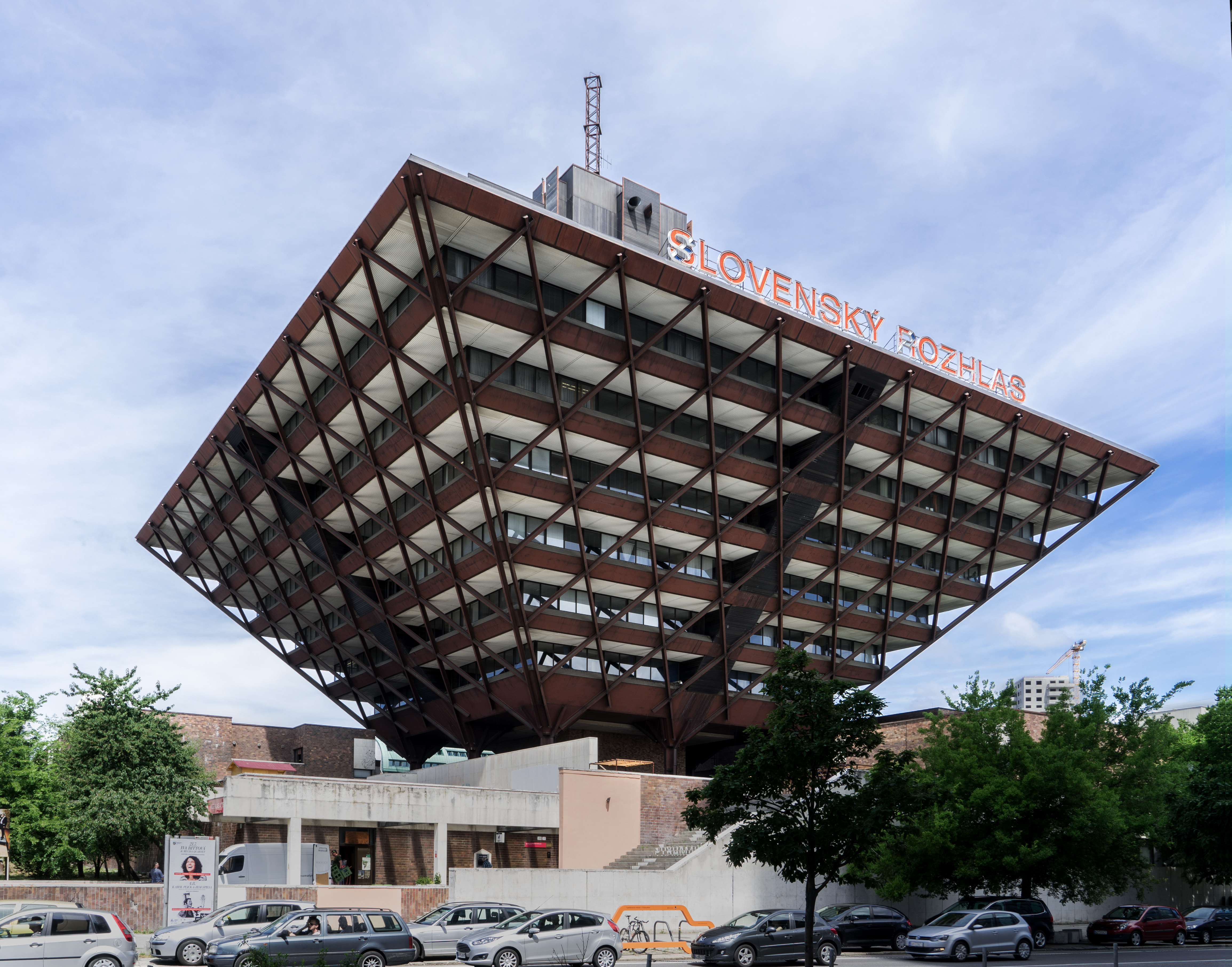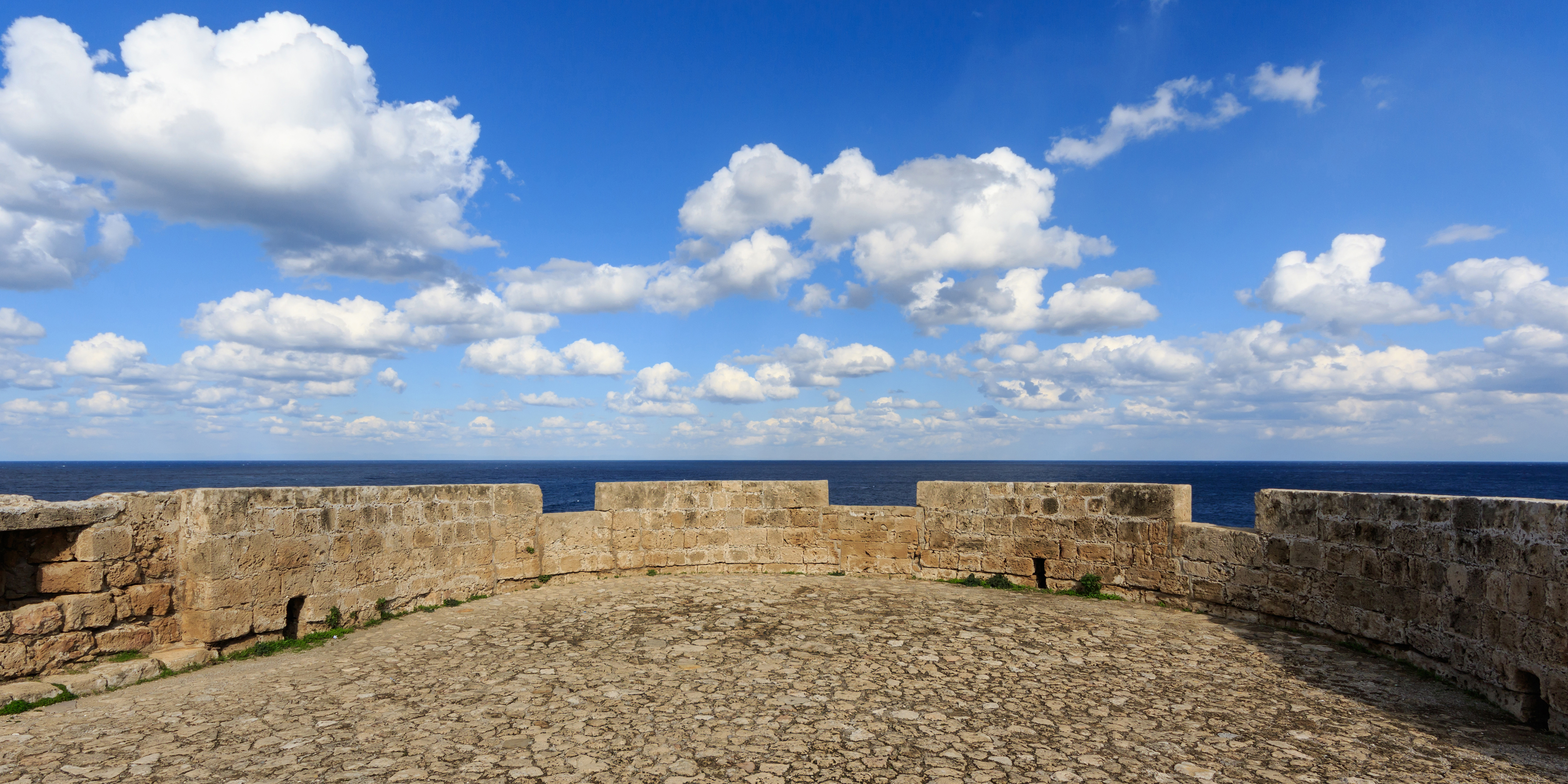|
Barthels Hof
Barthels Hof is a former trade court building complex in Leipzig in Germany, located in the borough Mitte. It is the last “through courtyard” that was preserved almost in its original condition. That means, the carts drove in, the goods were unloaded, and the carts drove out - without turning around. The horses were stabled in the suburbs. Later, from 1893 on, only samples of the goods were shown in the trade fairs and made to order. The Barthels Hof stretches from the market square to Kleine Fleischergasse and is now one of the city's most important sights. Today, it is used for a restaurant and some small shops. History Barthels Hof was built between 1747 and 1750 by George Werner (1682-1758) for the Leipzig merchant Gottlieb Barthel, when ″Leipzig was one of the leading trade and trade-fair cities on the continent". The baroque facade facing Fleischergasse is very narrow and inconspicuous, in contrast to the big building complex behind it. Four-story houses are arranged ... [...More Info...] [...Related Items...] OR: [Wikipedia] [Google] [Baidu] |
Baroque Architecture
Baroque architecture is a highly decorative and theatrical style which appeared in Italy in the early 17th century and gradually spread across Europe. It was originally introduced by the Catholic Church, particularly by the Jesuits, as a means to combat the Reformation and the Protestant church with a new architecture that inspired surprise and awe. It reached its peak in the High Baroque (1625–1675), when it was used in churches and palaces in Italy, Spain, Portugal, France, Bavaria and Austria. In the Late Baroque period (1675–1750), it reached as far as Russia and the Spanish and Portuguese colonies in Latin America. About 1730, an even more elaborately decorative variant called Rococo appeared and flourished in Central Europe. Baroque architects took the basic elements of Renaissance architecture, including domes and colonnades, and made them higher, grander, more decorated, and more dramatic. The interior effects were often achieved with the use of '' quadratura ... [...More Info...] [...Related Items...] OR: [Wikipedia] [Google] [Baidu] |
Bay Window
A bay window is a window space projecting outward from the main walls of a building and forming a bay in a room. Types Bay window is a generic term for all protruding window constructions, regardless of whether they are curved or angular, or run over one or multiple storeys. In plan, the most frequently used shapes are isosceles trapezoid (which may be referred to as a ''canted bay window'') and rectangle. But other polygonal shapes with more than two corners are also common as are curved shapes. If a bay window is curved it may alternatively be called '' bow window.'' Bay windows in a triangular shape with just one corner exist but are relatively rare. A bay window supported by a corbel, bracket or similar is called an oriel window. "Rawashin" is a traditional and distinctive style of corbelled bay window in Jeddah, Saudi Arabia (e.g., as on the frontage of Nasseef House). Uses Most medieval bay windows and up to the Baroque era are oriel windows. They frequently ap ... [...More Info...] [...Related Items...] OR: [Wikipedia] [Google] [Baidu] |
Baroque Architecture In Saxony
The Baroque (, ; ) is a style of architecture, music, dance, painting, sculpture, poetry, and other arts that flourished in Europe from the early 17th century until the 1750s. In the territories of the Spanish and Portuguese empires including the Iberian Peninsula it continued, together with new styles, until the first decade of the 19th century. It followed Renaissance art and Mannerism and preceded the Rococo (in the past often referred to as "late Baroque") and Neoclassical styles. It was encouraged by the Catholic Church as a means to counter the simplicity and austerity of Protestant architecture, art, and music, though Lutheran Baroque art developed in parts of Europe as well. The Baroque style used contrast, movement, exuberant detail, deep colour, grandeur, and surprise to achieve a sense of awe. The style began at the start of the 17th century in Rome, then spread rapidly to France, northern Italy, Spain, and Portugal, then to Austria, southern Germany, and Russia. By ... [...More Info...] [...Related Items...] OR: [Wikipedia] [Google] [Baidu] |
Buildings And Structures In Leipzig
A building, or edifice, is an enclosed structure with a roof and walls standing more or less permanently in one place, such as a house or factory (although there's also portable buildings). Buildings come in a variety of sizes, shapes, and functions, and have been adapted throughout history for a wide number of factors, from building materials available, to weather conditions, land prices, ground conditions, specific uses, prestige, and aesthetic reasons. To better understand the term ''building'' compare the list of nonbuilding structures. Buildings serve several societal needs – primarily as shelter from weather, security, living space, privacy, to store belongings, and to comfortably live and work. A building as a shelter represents a physical division of the human habitat (a place of comfort and safety) and the ''outside'' (a place that at times may be harsh and harmful). Ever since the first cave paintings, buildings have also become objects or canvasses of much artist ... [...More Info...] [...Related Items...] OR: [Wikipedia] [Google] [Baidu] |
List Of Arcade Galleries In Leipzig
The arcade galleries in Leipzig developed in connection with the emergence of inner-city exhibition centers of the Leipziger Messe at the turn of the 20th century and are often based on old passageways. But the tradition of building passages has also been maintained in more recent times. The Leipzig passages and courtyards thus form a unique architectural quality in Leipzig-Mitte and run through the old city center parallel to the network of existing streets and alleys like a second, private path system that is only reserved for pedestrians. The list includes all the usable arcade galleries. See also * Architecture of Leipzig Literature * * Footnotes External links * * {{Portal, Germany, Saxony Buildings and structures in Leipzig Tourist attractions in Leipzig Shopping arcades ... [...More Info...] [...Related Items...] OR: [Wikipedia] [Google] [Baidu] |
Architecture Of Leipzig
The history of the architecture of Leipzig extends from the Middle Ages to the 21st century. Numerous typical buildings and valuable cultural monuments from History of construction, different eras are still preserved or have been rebuilt. Leipzig, Germany, begins its architectural history with several buildings in the Romanesque architecture, Romanesque style. An example of Gothic architecture in Leipzig is the late Gothic hall vault of the St. Thomas Church, Leipzig, Thomaskirche (1482/1496). In the early modern period, the Old Town Hall (Leipzig), Old Town Hall was expanded in the Renaissance architecture, Renaissance style. The city experienced the peak of urban design and artistic development from around 1870 to 1914 with Historicism (art), historicism, ''Reformarchitektur'' and Art Nouveau. Numerous Leipzig Trade Fair, trade fair palaces, commercial buildings, representative buildings such as the Imperial Court Building and the New Town Hall (Leipzig), new town hall and the L ... [...More Info...] [...Related Items...] OR: [Wikipedia] [Google] [Baidu] |
Broadcasting Station
Radio broadcasting is transmission of audio (sound), sometimes with related metadata, by radio waves to radio receivers belonging to a public audience. In terrestrial radio broadcasting the radio waves are broadcast by a land-based radio station, while in satellite radio the radio waves are broadcast by a satellite in Earth orbit. To receive the content the listener must have a broadcast radio receiver (''radio''). Stations are often affiliated with a radio network which provides content in a common radio format, either in broadcast syndication or simulcast or both. Radio stations broadcast with several different types of modulation: AM radio stations transmit in AM ( amplitude modulation), FM radio stations transmit in FM (frequency modulation), which are older analog audio standards, while newer digital radio stations transmit in several digital audio standards: DAB (digital audio broadcasting), HD radio, DRM (Digital Radio Mondiale). Television broadcasting is a ... [...More Info...] [...Related Items...] OR: [Wikipedia] [Google] [Baidu] |
1523
Year 1523 ( MDXXIII) was a common year starting on Thursday (link will display the full calendar) of the Julian calendar. Events January–June * January 20 – Christian II is forced to abdicate as King of Denmark and Norway. * May – The Ningbo Incident: Two rival trade delegations from Japan feud in the Chinese city of Ningbo, resulting in the pillage and plunder of the city. * June 3 – Santhome Church was established by Portuguese explorers over the tomb of Saint Thomas the Apostle in Chennai, India. * June 6 – Gustav Vasa is elected king of Sweden, finally establishing the full independence of Sweden from Denmark, which marks the end of the Kalmar Union. This event is also traditionally considered to be the establishment of the modern Swedish nation. July–December * c. July – Martin Luther's translation of the Pentateuch into German (') is published. * July 1 – Jan van Essen and Hendrik Vos become the first Flemis ... [...More Info...] [...Related Items...] OR: [Wikipedia] [Google] [Baidu] |
Latin
Latin (, or , ) is a classical language belonging to the Italic branch of the Indo-European languages. Latin was originally a dialect spoken in the lower Tiber area (then known as Latium) around present-day Rome, but through the power of the Roman Republic it became the dominant language in the Italian region and subsequently throughout the Roman Empire. Even after the fall of Western Rome, Latin remained the common language of international communication, science, scholarship and academia in Europe until well into the 18th century, when other regional vernaculars (including its own descendants, the Romance languages) supplanted it in common academic and political usage, and it eventually became a dead language in the modern linguistic definition. Latin is a highly inflected language, with three distinct genders (masculine, feminine, and neuter), six or seven noun cases (nominative, accusative, genitive, dative, ablative, and vocative), five declensions, four ... [...More Info...] [...Related Items...] OR: [Wikipedia] [Google] [Baidu] |
Parapet
A parapet is a barrier that is an extension of the wall at the edge of a roof, terrace, balcony, walkway or other structure. The word comes ultimately from the Italian ''parapetto'' (''parare'' 'to cover/defend' and ''petto'' 'chest/breast'). Where extending above a roof, a parapet may simply be the portion of an exterior wall that continues above the edge line of the roof surface, or may be a continuation of a vertical feature beneath the roof such as a fire wall or party wall. Parapets were originally used to defend buildings from military attack, but today they are primarily used as guard rails, to conceal rooftop equipment, reduce wind loads on the roof, and to prevent the spread of fires. In the Bible the Hebrews are obligated to build a parapet on the roof of their houses to prevent people falling (Deuteronomy 22:8). Parapet types Parapets may be plain, embattled, perforated or panelled, which are not mutually exclusive terms. *Plain parapets are upward extensio ... [...More Info...] [...Related Items...] OR: [Wikipedia] [Google] [Baidu] |
Coat Of Arms
A coat of arms is a heraldic visual design on an escutcheon (i.e., shield), surcoat, or tabard (the latter two being outer garments). The coat of arms on an escutcheon forms the central element of the full heraldic achievement, which in its whole consists of a shield, supporters, a crest, and a motto. A coat of arms is traditionally unique to an individual person, family, state, organization, school or corporation. The term itself of 'coat of arms' describing in modern times just the heraldic design, originates from the description of the entire medieval chainmail 'surcoat' garment used in combat or preparation for the latter. Rolls of arms are collections of many coats of arms, and since the early Modern Age centuries, they have been a source of information for public showing and tracing the membership of a noble family, and therefore its genealogy across time. History Heraldic designs came into general use among European nobility in the 12th century. Sys ... [...More Info...] [...Related Items...] OR: [Wikipedia] [Google] [Baidu] |
Corbel
In architecture, a corbel is a structural piece of stone, wood or metal jutting from a wall to carry a superincumbent weight, a type of bracket. A corbel is a solid piece of material in the wall, whereas a console is a piece applied to the structure. A piece of timber projecting in the same way was called a "tassel" or a "bragger" in England. The technique of corbelling, where rows of corbels deeply keyed inside a wall support a projecting wall or parapet, has been used since Neolithic (New Stone Age) times. It is common in medieval architecture and in the Scottish baronial style as well as in the vocabulary of classical architecture, such as the modillions of a Corinthian cornice. The corbel arch and corbel vault use the technique systematically to make openings in walls and to form ceilings. These are found in the early architecture of most cultures, from Eurasia to Pre-Columbian architecture. A console is more specifically an "S"-shaped scroll bracket in the classical ... [...More Info...] [...Related Items...] OR: [Wikipedia] [Google] [Baidu] |










